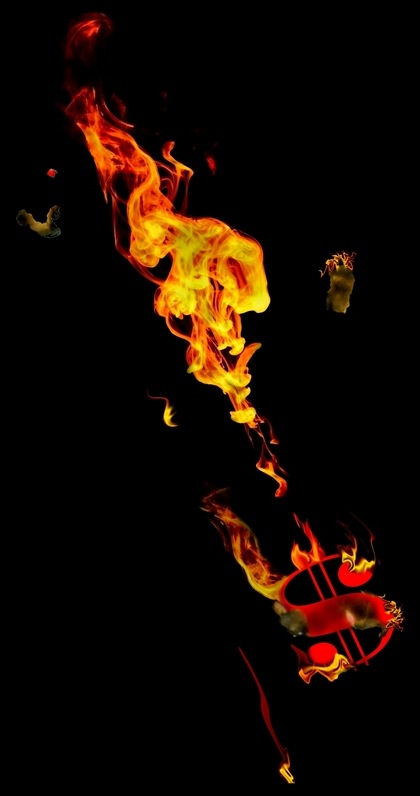2 Of America’s Important Shale Basins Are Now In The Red by Walter Kurtz, Sober Look, November 30, 2014, Business Insider
Although OPEC’s decision to maintain current crude production quotas was not entirely unexpected (see post http://soberlook.com/2014/10/the-saudis-have-staying-power-to.html), the market reaction was violent. WTI crude fell by 10% over the last two days of the week.
At $66 per barrel North American producers have real problems on their hands. While Eagle Ford is still profitable, both Bakken and Permian Basin are in now the red.
Scotiabank: – Based upon an analysis of more than 50 oil plays across Canada and the United States, we estimate that ‘mid-cycle breakeven costs’ in the North Dakota Bakken (1.05 mb/d) are roughly US$69 per barrel and in the Permian Basin in Texas (1.63 mb/d) about US$68. While some producers have hedged forward at higher prices, if WTI oil remains around US$70 for more than six months, it appears likely that drilling activity will slow in more marginal areas of these plays as 2015 unfolds. Funding for independent oil producers will also tighten. However, the ‘liquids-rich’ Eagle Ford (1.45 mb/d) will be little impacted, with breakeven costs averaging only US$50.
That’s why we’ve had such an extreme sell-off in US oil & gas shares on Friday…and Canadian shares underperformed…. If prices persist at current levels for months to come, the Saudis will achieve their objective of dealing a blow to North American oil production. Current expectations of the US outpacing Saudi Arabia as the number one oil producer…will be shelved for some time. And the only thing the US government could do at this point to support the domestic oil industry is to begin increasing the Strategic Petroleum Reserve. Of course such a measure would be temporary and if global demand does not improve, prices will begin falling again. [Emphasis added]
This article originally appeared at Sober Look. Copyright 2014.
Source: FrackingCanada How the West was Lost
Junk Bonds Backing Shale Boom Facing $11.6 Billion Loss by Nabila Ahmed and Sridhar Natarajan, December 02, 2014, Bloomberg Business News
Bond investors who helped finance America’s shale boom are facing potential losses of $11.6 billion as oil prices plummet by the most since the credit crisis.
The $90 billion of debt issued by junk-rated energy producers in the past three years has fallen almost 13 percent since crude oil peaked in June. Halcon Resources Corp. (HK:US), SandRidge Energy Inc. and Goodrich Petroleum Corp. have been among the hardest hit as OPEC’s refusal to ease a supply glut pushed prices to a five-year low of $66.15 a barrel last week.
The oil selloff is deepening concern among bond investors that the least-creditworthy oil explorers will struggle to pay their obligations and prompt bankers to rein in credit lines as revenue slumps. Halcon, SandRidge and Goodrich are among about 21 borrowers operating in the costliest U.S. shale-producing regions that will be unprofitable if crude oil falls below $60 a barrel, according to data compiled by Bloomberg.
“We are concerned that there will be defaults and that was even before oil fell as much as it has,” Ivan Rudolph-Shabinsky, a New York-based money manager at Alliance Bernstein Holding LP, said in a telephone interview. “There was too much money going into this space that would have resulted in problems long term — now that timeline has been accelerated.”
Junk Bonds
The 12.9 percent loss for junk-rated energy debt issued by U.S. and Canadian companies since January 2012 compares with a 2.2 percent decline for the broader U.S. speculative-grade market since June, Bank of America Merrill Lynch index data show. Yields on junk-rated energy bonds averaged 8.54 percent yesterday, the most since July 2010 and up from 5.68 percent in June.
Halcon Resources’s $1.15 billion of 9.75 percent securities issued in April 2013 have lost 33 percent since June 30, while SandRidge’s $750 million of notes sold in October 2012 have plunged 29 percent, Bloomberg data show. Goodrich Petroleum’s $275 million of debt issued at the start of 2012 has dropped 37 percent.
…
Companies have relied on debt financing to make up for cash shortfalls as they expanded, doubling energy bonds’ share of the high-yield market to 17 percent since 2008, according to a Oct. 14 report by Citigroup Inc.
Falling Oil
…
Lower oil prices will “affect cash flow but also capital spending, which in turn, affect projected production and cash flow in a downward spiral,” Gary Stromberg and Jan Trnka-Amrhein, analysts at Barclays Plc, wrote in a note to clients dated yesterday.
Borrowing Limits
Because the amount oil and gas companies are permitted to borrow from bank lenders is directly tied to the value of their reserves, falling commodity prices increase the risk they will face a cash squeeze, according to an Oct. 9 report by Spencer Cutter, an analyst at Bloomberg Intelligence in Skillman, New Jersey.
The extra yield investors demand to hold the bonds of energy companies instead of comparable U.S. Treasuries increased to 7.63 percentage points yesterday, more than double the premium in June, Bloomberg data show. The price of crude collapsed 35.7 percent during that period.
The issuance of debt has helped contribute to production growth in the U.S. and falling prices will make it harder for companies to meet their obligations, according to Virendra Chauhan, a London-based oil analyst with Energy Aspects Ltd.
“My sense is we’re just on the cusp of bad news there and we’ll see things get worse before they get better,” David Kurtz, global head of restructuring at Lazard Ltd., said at Beard Group Inc.’s Distressed Investing conference in New York yesterday. [Emphasis added]
Source: FrackingCanada How the West was Lost
[Refer also to:
The fracking fallacy: Banking on decades of abundant frac’d natural gas that might not be there? ]


